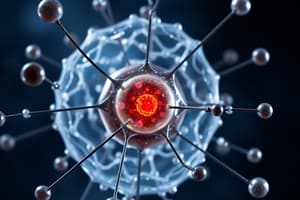Podcast
Questions and Answers
Which component of an atom carries a zero electric charge?
Which component of an atom carries a zero electric charge?
- Isotopes
- Neutrons (correct)
- Protons
- Electrons
What is the main role of protons in defining an atom's identity?
What is the main role of protons in defining an atom's identity?
- Determining the atomic number (correct)
- Influencing the atom's mass
- Affecting the electron cloud
- Creating unique chemical properties
Which region of an atom accounts for almost the entire mass of the atom?
Which region of an atom accounts for almost the entire mass of the atom?
- Proton space
- Nucleus (correct)
- Electron cloud
- Neutron area
What is the significance of neutrons in an atom?
What is the significance of neutrons in an atom?
Which component of an atom orbits around the positively charged protons?
Which component of an atom orbits around the positively charged protons?
How do protons and electrons differ in their electrical charges?
How do protons and electrons differ in their electrical charges?
What determines the chemical behavior and bond formation between atoms?
What determines the chemical behavior and bond formation between atoms?
In what type of regions are electrons found in electron clouds?
In what type of regions are electrons found in electron clouds?
What determines the number of electrons an orbital can accommodate?
What determines the number of electrons an orbital can accommodate?
How are electrons distributed in energy levels around the nucleus?
How are electrons distributed in energy levels around the nucleus?
What is the purpose of organizing elements in rows and columns in the periodic table?
What is the purpose of organizing elements in rows and columns in the periodic table?
What corresponds to increasing atomic size in the vertical columns of the periodic table?
What corresponds to increasing atomic size in the vertical columns of the periodic table?
Flashcards are hidden until you start studying
Study Notes
Exploring Atomic Structure
Atoms, the building blocks of all matter, exist as remarkably intricate structures composed of even more fundamental particles. In this exploration of atomic structure, we'll dive into the inner workings of these tiny entities that make up our world.
An atom consists of three main components: protons, neutrons, and electrons. Each type of element is characterized by its specific number of each component, which creates unique chemical properties. Let's unravel their roles in detail.
Nucleus
The nucleus, located near the center of the atom, contains both protons and neutrons. This dense region accounts for almost the entire mass of the atom while making up only a small fraction of its volume. Protons carry positive electrical charge (+1), whereas neutrons have zero electric charge. Together they determine the atomic number and mass number of an atom, respectively.
Protons are crucial because they define the identity of any given atom within the periodic table. For instance, hydrogen atoms contain one proton, helium has two, lithium three, etc., forming distinct elements. Neutrons play a significant role too since they influence the atom's mass without altering the kind of element it represents.
Electron Cloud
Surrounding the nucleus lies the electron cloud, filled with negatively charged electrons (-1) orbiting around the positively charged protons like planets revolving around the sun. These electrons move in energy levels known as orbitals, occupying different shells based on their distance from the nucleus. Orbitals can accommodate various numbers of electrons depending upon their energy level – starting from a single electron in the first shell.
Electron clouds do not consist of discrete particles but rather regions where electrons have a high probability of being found due to quantum mechanics. They serve several purposes, such as determining chemical behavior and bond formation between atoms.
Periodic Table Connection
In the periodic table, organized rows and columns represent varying electron configurations (arrangement of electrons) among elements. The horizontal arrangement corresponds to similar outermost electron arrangements (valence electrons), resulting in comparable chemical properties. In contrast, vertical columns correspond to increasing atomic size.
To summarize, an atom is built around a central nucleus comprising protons and neutrons, surrounded by electrons distributed in energy levels called orbitals. Understanding this structure enables us to comprehend the characteristics of elements and predict how atoms interact chemically through bonding.
Studying That Suits You
Use AI to generate personalized quizzes and flashcards to suit your learning preferences.




